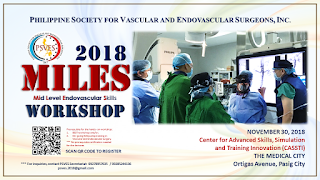Ortigas, Pasig City –
Indeed, PSVES walked miles and more today as it held its Mid Level Endovascular Skills (MILES)
Workshop at Center for Advanced
Skills , Simulation and Training Innovation of The Medical City last
November 30, 2018.
The workshop started off
with with lectures on sizing of the aorta done for two different systems for
endovascular aortic repairs, by Dr. Joy
M. Gali and Ms Ellen Joy J. Yballe. Both lectures were meant to empower
surgeons when doing endovascular repair of the aorta. As Mellisanno said,
accurate planning and sizing is key to the success of endovascular treatment of
aortic disease.“
 |
| Afternoon Session with the delegates |
It was followed by a lecture on the evolution of management of Peripheral Arterial Disease, the different perspectives of TASC I and II by Dr. Kristina Marie T. Zapanta. The lecture showed the participants how endovascular surgery is becoming the treatment of choice for atherosclerotic lesions, some in the early 2000, were deemed un-crosssble. However, it was emphasized that endovascular approach can only provide the best outcomes for the patients if done correctly.
Dr. Jeffrey L. Chua shared his expertise in the use of
plain old balloon - bare stents and drug coated balloons. His lecture was
reinforced more after he taught his audience about his tips and tricks in its
deployment. Again, it was shown in this lecture that Endovascular surgery is
just not knowledge of wires and catheters. The knowledge of its properties and
the mastery of the disease process should come hand in hand in managing patients.
Our PSVES President, Dr. Ricardo Jose T. Quintos II, on
the other hand, delivered a great lecture about thrombolysis and the use
different endovascular thrombectomy device.
The last lecture for the
morning was delivered by Dr. Leo Carlo
V. Baloloy where he discussed the merits of different management for
hemodialysis access. Then vascular surgeons used to be contented with creating
and creating of new vascular accesses, these days, vascular and endovascular
surgeons become proactive in management of pxs woth vascular access. From
creation, to trouble - shooting to surveillance, the role of vascular surgeons
was redefined.
 |
| Station -Based Rotation Learning and Lectures |
The afternoon session was also fun-filled as the participants started moving around different stations where they are taught on handling the different medical endovascular devices. The first 2 stations were assigned to the two endovascular aortic systems used in the country. Each participant had the opportunity to learn and deploy the system using glass models. The third station, was well - attended where the participants get the chance to perform peocedures, navigate the wires. angioplasty on our animal model. The POBA, stents and drug coated balloon and endovascular thrombectomy devices were assigned to the fourth station.
True to its mandate, PSVES continued being a strong advocate in improving the quality and safety of vascular and endovascular procedures and vascular care through training, education and research.

No comments:
Post a Comment